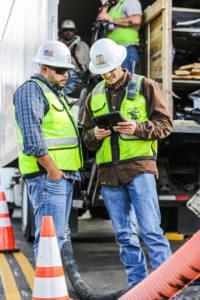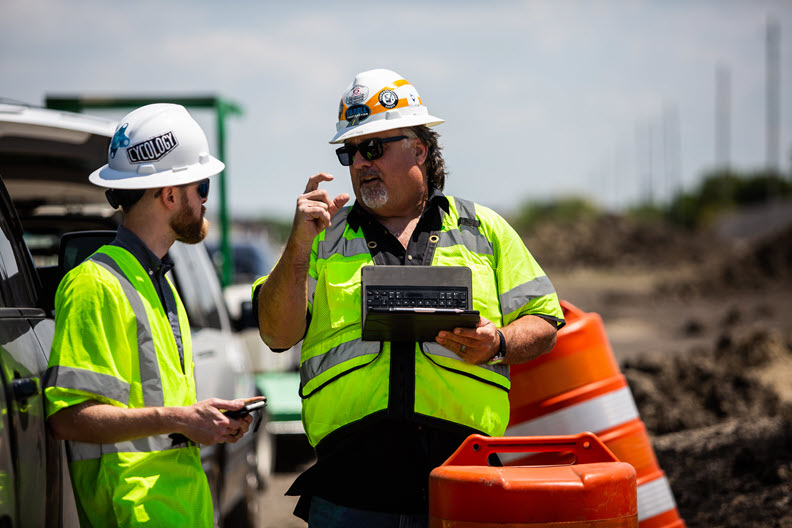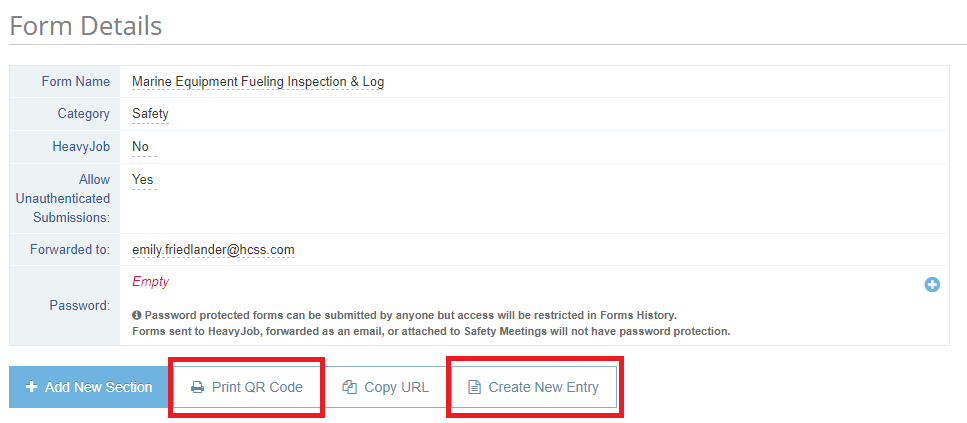It takes time to make a meaningful culture change within an organization.
For Cesar Martinez, Safety Manager for Achen-Gardner Construction, LLC, it took about a million man-hours, to be exact.
Earlier this year, Achen-Gardner hit a significant safety milestone when the Arizona-based civil general contractor reached one million man-hours without a lost-time incident. Those man-hours spanned about three years of work for the company’s approximately 140 employees.
But Martinez has been working on making Achen-Gardner safer for even longer.
Achen-Gardner safety manager Cesar Martinez, left, discusses the job with a coworker at a site.
 First Steps
First Steps
“When I started working with Achen-Gardner in 2012, our lost-time accident rate was not where it should be,” he said. “We had a lot of incidents, and a lot of guys were losing time because of them. It all came back to the fact that the incidents were not really properly managed when they did occur.”
Martines's first task was to create a return-to-work program that would help get injured employees back on their feet and back to making the company – and themselves – money.
But behind that idea was a bigger goal of eliminating incidents completely.
“We don’t want people getting hurt,” Martinez said. “That’s the bottom line. So we did a slow safety overrun of the existing program that we already had. I knew that if we didn’t have buy in from the guys in the field and the ownership and everybody across all levels of the company, it wouldn’t work. So I basically campaigned our safety program at first. I didn’t go out and say I would be making these big changes.”
Instead, Martinez’s first two months at Achen-Gardner were spent visiting employees on job sites and asking them what they knew about the company’s safety regulations and processes.
He asked them about things he knew they should be doing but weren’t what happened when a worker got hurt, or how they ran through different safety scenarios.
“I figured out that they didn’t know the safety program,” Martinez said. “So I started writing a new safety program for our company on all the information I got from the guys in the field, everything they should be doing but weren’t and everything they were already doing that wasn’t written policy. It really was about gaining trust from the guys in the field that we were out there to help them – that was huge.”
Retraining the Team
Then he began retraining the entire company, from field workers to project managers and superintendents to the owners and executives of the company.
“We did a lot of training with the guys so they could understand the importance of their responsibilities and what safety is all about,” he said. “We were trying to develop the foundation for a safety culture.”
Martinez said the training was tailored and presented differently for the different levels within Achen-Gardner, but the overarching message was the same: get employees home safe, and bring down the company’s incident numbers.
“We do a lot of work where EMR matters,” he said. “If we have a high EMR, that means we can’t bid for jobs. That takes work away from the guys in the field, so they get it, and the owners understand that message too.
Martinez said getting upper management involved makes a huge statement to the rest of the company that Achen-Gardner is serious about safety.
In the end, the message got across to the entire company, which managed to get its lost-time accidents under control quickly. Achen-Gardner also went a full year without a single recordable accident – an incident that goes beyond the level of requiring simple first aid – and nearly did so again this past year.
“We did have a couple of incidents at the first aid level that didn’t get to that recordable point,” Martinez said. “We would’ve done that again this year, but we had one incident where a guy got a little sick and had to go to a clinic, where he was prescribed a prescription. That caused it to turn into a recordable incident.”
What's Next
Now that Achen-Gardner has hit the big million man-hour milestone, Martinez said it isn’t time to quit working on becoming safer. He said he’s constantly working to evolve and improve the company’s safety culture to ensure all of his employees go home safely each year.
“It’s like we’re the champions, and we have to defend that championship,” he said. “We’re not looking at numbers anymore. We want to get the guys in the field involved a little bit more. We already have a good safety program and culture, but we’ve got to keep driving it home every day.”
Martinez said the company is working on a family safety fair where employees and their families can learn about everyday safety topics, and he is also working on implementing what he calls a “Target Zero” program.
“We’re going to do a campaign for zero accidents, zero incidents,” he said. “At the beginning of each job, the senior project manager is going to go to the job site and talk about what the project is about, what we’ve got going on, and the major hazards so he knows what we’re dealing with. And everyone will sign a commitment banner that says, ‘I’m committed to zero incidents.’ Little things like that will help us stay ahead of the game.”
How HCSS Safety Helps
Martinez also uses HCSS Safety to help keep each job site safe and help the crews plan their day. The mobile app and manager portal track incidents, near misses, and observations; perform toolbox talks and inspections; track employee skills and certifications; and spot leading indicators and trends to drive strategic training.
Each site does a Job Hazard Analysis on a daily basis to break down the tasks for the day and the hazards involved and discuss them with the workers.
“Before they even start their work, they know what they’re going to be dealing with for the day and what hazards they will encounter and how to eliminate those,” Martinez said.
Each job site also has a toolbox safety meeting every Monday morning, with relevant topics regarding activities that will be occurring throughout the week or anything that happened the week before. And each superintendent will have a daily huddle with their crew every morning as well.
“They’ll go over the JHA and also do their daily safety inspections,” Martinez said. “You have your trenching excavation inspections, equipment inspections, and things like that. That keeps us informed, and it keeps us accountable.”
Martinez uses the inspections to see that each crew leader is doing what they are supposed to and that each worker is participating.
Planning is Important
They also ensure that each crew is adequately planning for their work and has the right tools and equipment needed for the job, which is important for quality and safety.
“If you don’t have the right equipment or tools, now you’re using the wrong tool, and because you didn’t have the right tool and had to go look for something else to use, now the schedule is pushed back and you’ve lost time in production,” Martinez said. “Now they’re trying to get a tool that is not the right one for the job and trying to bang out the work real fast to get ahead of schedule. Now the exposure is greater. They’re rushing, they may either get hurt or there may be some issues with quality.”
Proper planning, which leads to safety, production, and quality throughout their work, can help prevent that vicious cycle, Martinez said.
But in the end, it’s not only about quality work and low EMR rates. The company-wide effort to increase safety is about sending each employee home to his or her family every night.
“We have guys that have left and worked at other companies that end up coming back, and they say that once you leave this place, you realize how much more emphasis is put on safety here and how much more we care about them,” Martinez said. “But they’re the ones that made it happen. I was just behind the wheel. They’re the ones putting in the work, and they’re very happy and proud about that."



